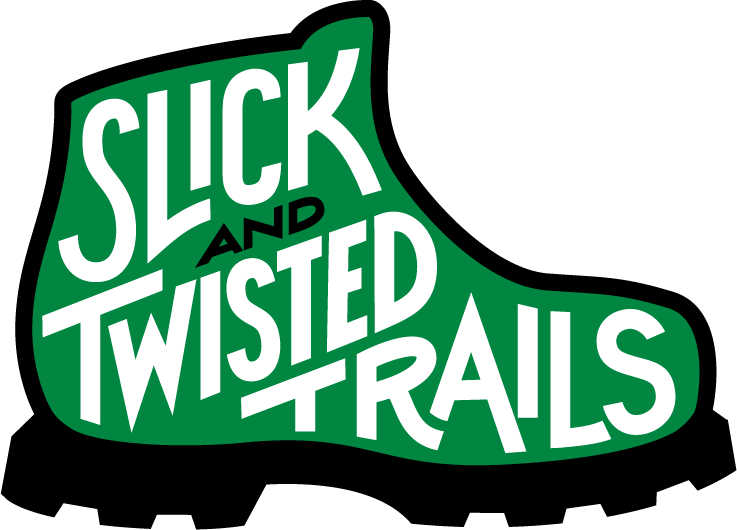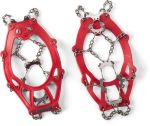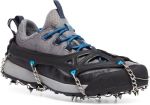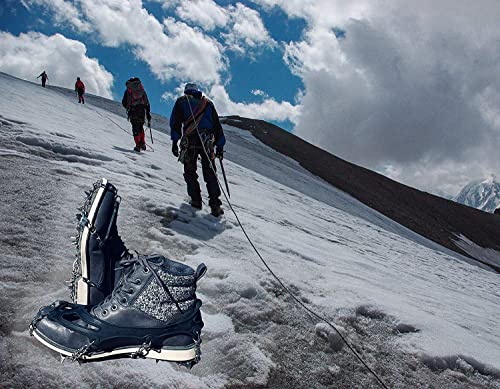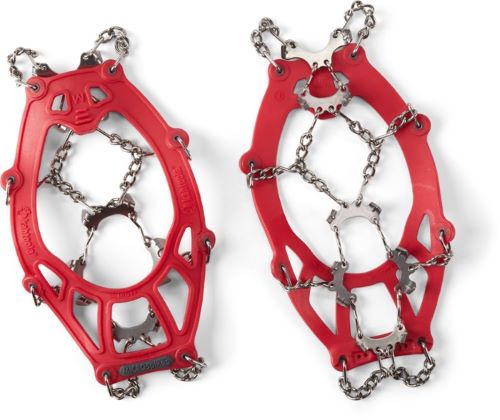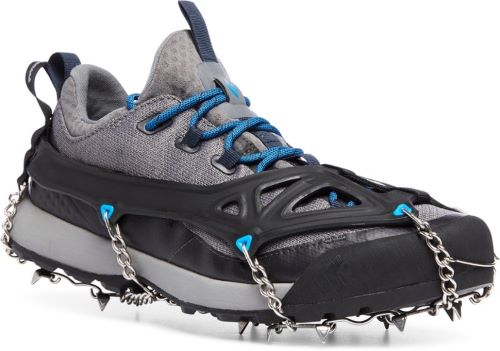Let me set the scene. You have decided to go for a hike in late Fall or early Spring. Sure it’s a little chilly out, but you’re a seasoned hiker, and you can handle it. The cold doesn’t get to you, but what you did not expect was your new pair of Solomons slipping and sliding all over the trail. Maybe it’s time to invest in some microspikes, just to keep in your day pack on the off chance that you find yourself staring at an ice slide that was once a trailhead.
Now that you have made this critical decision in your hiking career, it’s time to figure out just what type of microspikes you need. Do not be afraid. Getting new gear is half the fun of hiking.
|
Name |
Weight |
Type |
Rating |
Notes |
|---|---|---|---|---|
|
11 oz |
Spikes |
Our Top Pick |
||
|
2) Yaktrak Pro Traction Cleats  |
4 oz |
Coils |
Traction cleats that fit over shoes for safely walking, hiking, or jogging on packed snow or ice |
|
 |
19.2 oz |
Spikes |
These spikes are built to last and are covered by a category leading two-year warranty |
|
|
15 oz |
Cleats |
Full foot anti-slip protection with 18 steel metal studs. |
||
 |
18 oz |
Cleats |
Crampons are a combo of premium stainless steel and 5mm reinforced high-elastic TPE rubber, capped by 19 hardened spikes. |
|
|
7.4 oz |
Cleats |
14 spikes per side with a 8mm spike length provide excellent engagement on snow and ice as well as improved stability on rock and hard surfaces |
||
 |
10 oz |
Nano Spikes |
BEST FOR: Road running and walking on sidewalks and city streets in hard-packed snow or icy conditions. NANOspikes footwear traction are designed for safely transitioning between dry and slippery pavement, while providing the high-performance road runners demand to train outdoors all year round. |
When to use microspikes
Think of microspikes as you would putting chains on your tires. Do you always need them? No, but when you do, they are immensely helpful in making sure you do not slide into a tree. There are a variety of different microspike designs, but most are spikes, cleats, or coils. Regardless of the type, these metal instruments are fixed to your boots with a rubber casing that slips over your toe and heel. Spikes are the most popular type of microspikes and usually come with ¼ to ½ inch spikes placed toward your boot’s insole. Many people like cleats and coils, but more on that later. Microspikes give you that extra grip to get up and over tricky icy terrain. In addition, they are lightweight and durable. That said, most people typically keep them in their pack until they are needed. Microspikes are not just for your average hiker, though. Trailrunners are partial to microspikes because their lightweight does not impair their speed much, and they make running on the ice far safer. This is also why many people use microspikes to shovel their driveway after a big storm. Their ease of use and extra grip also makes them great for slippery asphalt. In general, microspikes are perfect for icy and relatively flat trails. However, if you plan on traveling through a deep snowpack, you will want a pair of snowshoes. Adversely, if you are faced with a wall of ice, you are going to need some crampons. All three have their uses, and they are by no means interchangeable.
How to choose between microspikes or crampons
Unless you are climbing a frozen waterfall, then odds are you don’t need crampons. If microspikes are chained tires, then crampons are monster truck wheels. They are bigger, they are badder, and if you have them on, then you are probably about to do something extreme.Here is a little breakdown of the differences between crampons and microspikes:
|
Microspikes |
Crampons |
|
|---|---|---|
|
Weight |
Microspikes are a lot lighter when compared to crampons. | Long spikes and heavy-duty steel make these pretty heavy for your feet. |
|
Price |
Even the highest quality microspikes are going to be far cheaper than crampons. | A good pair of crampons will be at least twice as expensive as the most expensive microspikes. |
|
Maintenance |
You just need to wipe them down after a day of hiking. | Since you will be using these for intense situations, maintenance is huge. Crampons need to be sharpened and checked for issues every time you use them. |
|
Ease of use |
Anyone can use microspikes. Just slide them on and start walking. | Crampons require training to use properly. If you are unfamiliar with climbing ice, then someone will have to teach you how to use crampons. |
|
Slippage |
After prolonged use, microspikes have a tendency to slip around your boot. This is why most people only break them out when they are absolutely necessary. | Crampons are locked into your boot and will not be going anywhere. |
|
Versatile |
Microspikes can go anywhere with ice. | You will do damage to your crampons if you are using them for something other than climbing. |
|
Durability |
Microspikes are not nearly as durable as crampons. | Given what they are used for, crampons have to be very durable. |
When it comes down to it, there is a place and time for microspikes and crampons. If you are going for a winter hike on a well-used trail with no severe inclines, then microspikes are perfect. However, if your pack list for that day includes an ice axe, then you are probably going to need crampons as well. Also, remember that many microspikes are called crampons, but if their spikes are smaller than a ½ inch, they are microspikes and should be used for hiking and not climbing.
What to consider when choosing microspikes for hiking
Usage
When choosing microspikes, you really want to narrow down what kind of hiking you plan on doing. Traversing four-thousand footers versus a leisurely nature walk through your local park will require very different types of microspikes.
Design
There are 3 main kinds of microspikes, and each has their specific areas of use. So be sure to figure out which type of microspike is best for your needs before you buy.
Spikes
Spikes are the heaviest-duty type of microspikes you can get. They are proper spikes that can handle more intense inclines. Usually, these spikes are around ¼ to ½ inches and are perfect for trail hiking.
Cleats
Cleats are popular among trailrunners because of their lightweight. They are perfect for maintaining speed on relatively flat sections of trail, but if you are trying to scale a mountain, you will start to slip. Keep in mind cleats, and spikes look very similar, but spikes are longer and there are usually only 10 to 12 spikes per foot. Cleats, however, are stubbier and can have 18 to 24 per foot.
Coils
Coils are the lightest and often cheapest type of microspike you can get. They are suitable for short, well-traveled trails that are not too intense. Since they are made of coils and not spikes or studs, they tend to slide on your boot after prolonged use.
Side note on Nanospikes:
Nanospikes are a fairly new product that are purely made for the road. If you’re worried about slipping on the blacktop on your morning run, then nanospikes might be good for you. These are incredibly lightweight but are not made for anything that is not flat blacktop.
Price
Always consider your budget for microspikes. If you plan only to use your microspikes once or twice a year, then you probably don’t need the most expensive pair on the market. That said, traditional spikes will be on the more expensive side, while cleats and coils are far cheaper.
Durability
Durability is one of the most important aspects of microspikes. Be sure to keep in mind that, while coils and cleats are cheaper, they tend to only last for one or two seasons when used often. So if you want something more heavy-duty and plan to do a lot of winter hiking, get spikes.
The top 7 microspikes for Hiking
So you’ve decided that your pack needs a pair of microspikes so that you can be ready for any kind of condition this winter. You have narrowed down your uses, the design you want, and the approximate cost you are willing to pay for them. The next question is, which one should you choose? With so many on the market, finding the right one for you might be tricky, so we’ve compiled our top 7 to save you from sweating once you see the wall of microspikes at your local REI.
TOP PICK!
1) Kahtoola MICROspikes Tractions System (Our Top Pick)
Katatoola are probably the best microspikes money can buy. Unfortunately, they are also some of the most expensive microspikes money can buy. That said, your money gets you reinforced eyelets for increased durability, toe bales that hold spikes in place, and steel flex chains to prevent snowballing. They also come with heel tabs for easy on/off and a very fashionable tote sack. You are going to want a pair of Katatoolas if you are doing a multi-day hike where you will be tackling a lot of snow-covered miles. Having said that, they also will work great for day hikes, but if you do not plan on using your microspikes a lot, then there are tons of other options at more affordable prices.
PROS
- Reliable brand
- Heavy duty
- Lightweight
- 2-year warranty
CONS
- Expensive
| INFO |
DATA |
|---|---|
| Price |
$74.95 |
| Type |
Spikes |
| Weight |
11 oz (medium) |
| Other Info |
12 ⅜ in spikes per foot. |
2) Yaktrak Pro Traction Cleats

Lots of day hikers like coil microspikes because they are the lightest and often cheapest option you can get. With that in mind, Yaktraks are a little more on the expensive side because they are some of the most trustworthy coil microspikes on the market. These are great for flat trails with snow and ice, but once any serious incline comes along, you will start to slip. This is because, while coils provide more all-around traction, the fact that they are so small makes them less than ideal for significant hills.
PROS
- Price
- Extremely lightweight
- Very low maintenance
CONS
- Not great for inclines
| INFO |
DATA |
|---|---|
| Price |
$29.99 |
| Type |
Coils |
| Weight |
4 oz (medium) |
| Other Info |
Stainless steel coils |
3) Hillsound Trail Crampon

These claim to be crampons, but they are really just microspikes. Lots of companies do this, so keep an eye out. If the spikes in question do not have toe spikes, then they are microspikes and not crampons. That aside, these are a great pair of microspikes. Unfortunately, they are also the heaviest pair of microspikes on this list. While 19.2 oz does not sound like much, you will notice a big difference when they are strapped on your feet.
PROS
- Very durable
- Long spikes
CONS
- Heavy
- Expensive
| INFO |
DATA |
|---|---|
| Price |
$69.00 |
| Type |
Spikes |
| Weight |
19.2 oz (medium) |
| Other Info |
11 ⅔ inch carbon steel spikes per foot 2-year warranty |
4) Limm Crampons Ice Traction Cleats
Limm’s come in at an unbeatable price for microspikes. For less than $16, you can be out on the trails no matter the condition. They are cleats, so they will not be doing anything too crazy. Still, they are an excellent choice for the occasional winter hiker. However, the rubber they use for these does have a tendency to break, especially when the weather is particularly cold. So if you are planning on really getting a lot of use out of your microspikes, then you may want to look elsewhere.
PROS
- Unbeatable price
CONS
- Not as durable
| INFO |
DATA |
|---|---|
| Price |
$15.79 |
| Type |
Cleats |
| Weight |
15 oz (medium) |
| Other Info |
18 studs per foot |
5) Sportneer Ice Cleats

These are a great pair of microspikes at a very affordable price. Perfect for when you need a little help on an icy slope every once and a while. They are on the heavier side, and if you use them for a long time, they will slide around your boot. But, like Limms, Sporneers are perfect for the occasional ice hiker.
PROS
- Price
CONS
- Heavy
- Can slip on your boot
| INFO |
DATA |
|---|---|
| Price |
$17.59 |
| Type |
Cleats |
| Weight |
18.0z (medium) |
| Other Info |
19 spikes per foot |
6) Black Diamond Access Spike Traction Devices
These microspikes are made specifically for trailrunners. Hence, why they are extremely lightweight, especially for cleat microspikes. With this in mind, they are not the best choice if you are looking for the most heavy-duty pair of microspikes on the market. Unfortunately, since the materials are lighter, they are not as sturdy as some of the other spikes. This specialization also comes at a cost, placing these microspikes at the higher end of the spectrum. That said, if you are a winter trail runner, there really is no better choice than Black Diamonds.
PROS
- Made for trailrunners
- Incredibly lightweight
CONS
- Expensive
- Not the most durable
| INFO |
DATA |
|---|---|
| Price |
$74.95 |
| Type |
Cleats |
| Weight |
7.4 oz (medium) |
| Other Info |
14 spikes per foot |
7) Kahtoola NANOspikes

Whether or not these are technically microspikes is up for debate, but they were interesting enough that I felt obligated to add them to the list. Unlike your other options, NANOspikes are made purely for the road. Built for runners that do not want to stop training because it is a little icy out, they add some much-needed grip to your sneakers without too much added weight. These would be perfect for snow shovelers and anyone worried about their walk to work if it looks icy out as well.
PROS
- Ideal for asphalt and sidewalks
- Lightweight
CONS
- Not made for offroad
- On the expensive side
| INFO |
DATA |
|---|---|
| Price |
$39.96 |
| Type |
nano spikes |
| Weight |
10 oz (medium) |
| Other Info |
10 spikes per foot |
Conclusion
At the end of the day, you want to get microspikes that are fit for your needs so that you can be hiking safely regardless of the season. They are superb for well-tread trails that do not involve any climbing. If you want to climb, then get a pair of crampons, and if you are going to trek through feet of snow, then get snowshoes. Microspikes are good in the right situations, so do not try to make them do what they are not intended to. When looking for your microspikes, keep in mind what you will be using them for, the design best fit for that use, and the price you are willing to pay. Whether that’s for spikes, cleats, or coils. Microspikes are an essential piece of gear for any hiker looking to get some miles in during the winter months. So treat yourself to a pair and stop worrying about if your boots can handle the ice. https://pluginstorrents.com/ https://whitecrack.com/ https://hdlicensed.com/ https://plug-torrents.com/ https://cracks4soft.com/
